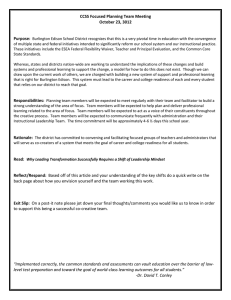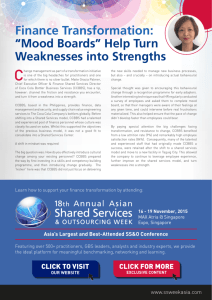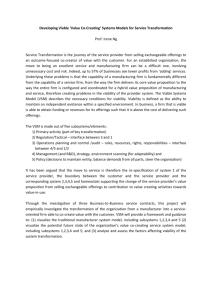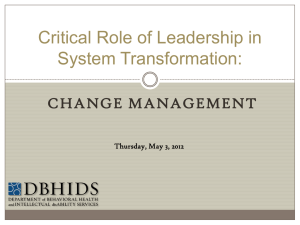Co-creative Leadership
advertisement
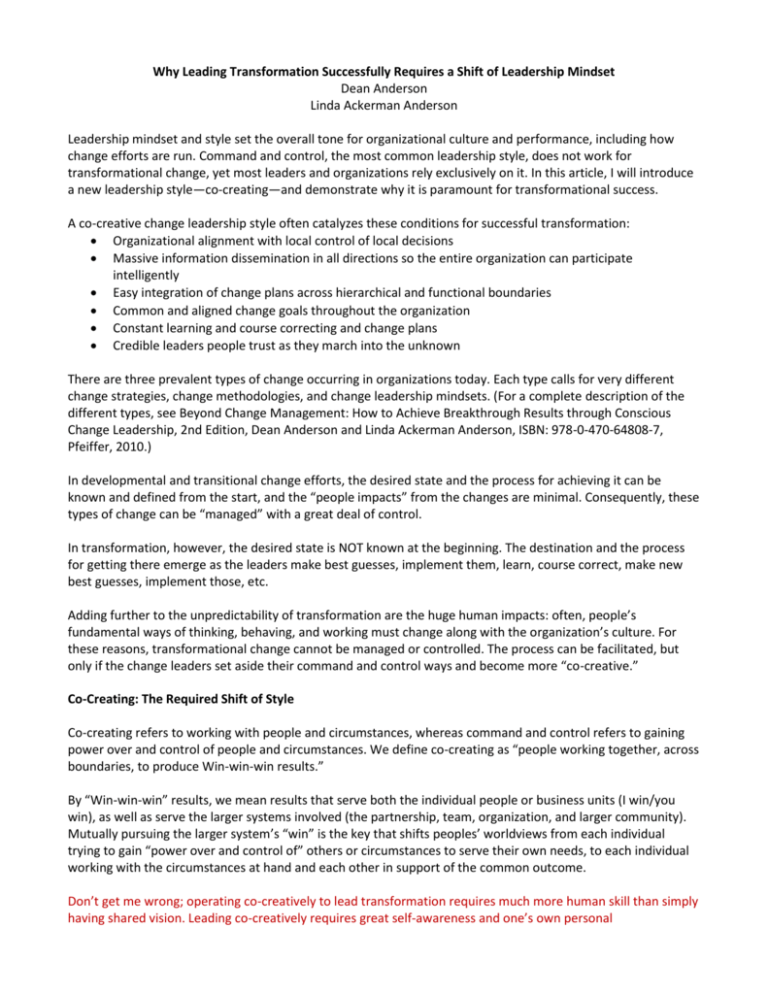
Why Leading Transformation Successfully Requires a Shift of Leadership Mindset Dean Anderson Linda Ackerman Anderson Leadership mindset and style set the overall tone for organizational culture and performance, including how change efforts are run. Command and control, the most common leadership style, does not work for transformational change, yet most leaders and organizations rely exclusively on it. In this article, I will introduce a new leadership style—co-creating—and demonstrate why it is paramount for transformational success. A co-creative change leadership style often catalyzes these conditions for successful transformation: Organizational alignment with local control of local decisions Massive information dissemination in all directions so the entire organization can participate intelligently Easy integration of change plans across hierarchical and functional boundaries Common and aligned change goals throughout the organization Constant learning and course correcting and change plans Credible leaders people trust as they march into the unknown There are three prevalent types of change occurring in organizations today. Each type calls for very different change strategies, change methodologies, and change leadership mindsets. (For a complete description of the different types, see Beyond Change Management: How to Achieve Breakthrough Results through Conscious Change Leadership, 2nd Edition, Dean Anderson and Linda Ackerman Anderson, ISBN: 978-0-470-64808-7, Pfeiffer, 2010.) In developmental and transitional change efforts, the desired state and the process for achieving it can be known and defined from the start, and the “people impacts” from the changes are minimal. Consequently, these types of change can be “managed” with a great deal of control. In transformation, however, the desired state is NOT known at the beginning. The destination and the process for getting there emerge as the leaders make best guesses, implement them, learn, course correct, make new best guesses, implement those, etc. Adding further to the unpredictability of transformation are the huge human impacts: often, people’s fundamental ways of thinking, behaving, and working must change along with the organization’s culture. For these reasons, transformational change cannot be managed or controlled. The process can be facilitated, but only if the change leaders set aside their command and control ways and become more “co-creative.” Co-Creating: The Required Shift of Style Co-creating refers to working with people and circumstances, whereas command and control refers to gaining power over and control of people and circumstances. We define co-creating as “people working together, across boundaries, to produce Win-win-win results.” By “Win-win-win” results, we mean results that serve both the individual people or business units (I win/you win), as well as serve the larger systems involved (the partnership, team, organization, and larger community). Mutually pursuing the larger system’s “win” is the key that shifts peoples’ worldviews from each individual trying to gain “power over and control of” others or circumstances to serve their own needs, to each individual working with the circumstances at hand and each other in support of the common outcome. Don’t get me wrong; operating co-creatively to lead transformation requires much more human skill than simply having shared vision. Leading co-creatively requires great self-awareness and one’s own personal transformation to being free of the ego’s habits of commanding and controlling. It compels leaders to let go of the mechanistic, military model of organizations (hierarchy, separation of departments), and instead to see organizations as inter-connected, evolving human systems. When leaders operate co-creatively during change, they: Put the priority of the larger organization first, not their own self-interests or political agendas Smoothly integrate change initiatives across departments, regions, or business units Share information about the case for change, the change strategy, and the future state design (withholding information only limits people’s contribution) Allow for local control of decisions by sharing power and authority Remove unnecessary hierarchy or barriers to performance Maximize participation and involvement so the whole system mobilizes the change collectively Operate with clear roles and accountabilities because they see that usurping each other’s power only weakens the organization’s overall capacity to change These are many of the human requirements of successful organization transformation. You cannot force people to march into the unknown with blind faith, or force them to change their mindsets, behavior, or ways of working. You can, however, co-create with them in such a way that they desire to contribute to the transformation’s success in all ways possible because it serves something they want to produce! Change leaders will never get such commitment from command and control. There is a tremendous dilemma embedded in this discussion: how can change leaders transform their organizations if they have not yet transformed their own mindsets and style? Clearly, they cannot. However, this is not a chicken and egg issue; mindset change does not need to precede the organization’s transformation. They can occur together. Organization development consultants should attempt to ensure that every transformational change strategy leadership mindset. With their knowledge of personal change, organization development consultants can be key players in supporting this most vital change leadership breakthrough. When change leaders employ plans that include “command and control” as their dominant change for shifting leadership style, they often: Cause resistance Adhere to preconceived change plans instead of course correcting as needed Don’t allow the necessary local control of change decisions Alienate employees by not sharing information Neglect the human, emotional transition phases of transformation Lose credibility by not modeling the behavior and culture change they are advocating Overlook communicating critical change information Fail to intrinsically motivate and build a critical mass of support http://changeleadersnetwork.com/free-resources/why-leading-transformation-successfully-requires-a-shift-ofleadership-mindset
